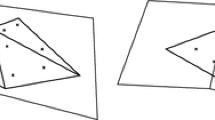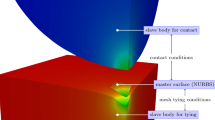Abstract
In this paper, we present a high-order mortar-based contact element for the solution of two and three-dimensional frictional contact problems, considering small and large deformations. The Neo-Hookean isotropic compressible hyperelastic material model is considered. The mapping of curved surfaces of elements is performed with Non-Uniform Rational B-Splines. The behavior of the element in small and large deformations is verified by comparing it with solutions available in the literature, presenting studies of accuracy and processing time exhibited by the contact elements considering the h- and p-refinements. The comparative results show that the high-order interpolation is a strategy which has a better performance for the contact problems analysed, while improving solution accuracy of the contact stresses and forces with a lower processing time.







































Similar content being viewed by others
References
Buffa A, Sangalli G, Vazquez R (2010) Isogeometric analysis in electromagnetics: B-splines approximation. Comput Methods Appl Mech Eng 199:1143–1152
Bathe KJ (1982) Finite element procedures in engineering analysis. Prentice-Hall, Upper Saddle River
Bathe KJ (2008) On finite element methods for nonlinear dynamic response. In: Seventh conference on structural dynamics
Bathe KJ, El-Abbasi N (2001) Stability and path test performance of contact discretizations and a new solution algorithm. Comput Struct 79:1473–1486
Bazilevs Y, Hughes TJR (2008) NURBS-based isogeometric analysis for the computation of flows about rotating components. Comput Mech 43:143–150
Bazilevs Y, Gohean J, Hughes TJR, Moser R, Zhang Y (2009) Patient-specific isogeometric fluid-structure interaction analysis of thoracic aortic blood flow due to implantation of the jarvik 2000 left ventricular assist device. Comput Methods Appl Mech Eng 198:3534–3550
Belgacem FB, Hild P, Laborde P (1998) The mortar finite element method for contact problems. Math Comput Model 28:263–271
Bernardi C, Debit N, Maday Y (1990) Coupling finite element and spectral methods: first results. Math Comput 54:21–39
Bittencourt ML (2014) Computational solid mechanics: variational formulation and high order approximation. CRC Press, Boca Raton
Corbett CJ, Sauer RA (2014) Nurbs-enriched contact finite elements. Comput Methods Appl Mech Eng 275:55–75
Corbett CJ, Sauer RA (2015) Three-dimensional isogeometrically enriched finite elements for frictional contact and mixed-mode debonding. Comput Methods Appl Mech Eng 284:781–806
Cottrell JA, Hughes TJR, Bazilevs Y (2009) Isogeometric analysis. Wiley, New York
Crisfield MA (2000) Non-linear finite element analysis of solids and structures, vol 1, 1st edn. Wiley, Hoboken
Crisfield MA (2000) Non-linear finite element analysis of solids and structures, vol 2, 1st edn. Wiley, Hoboken
Curnier A, Wriggers P, Panagiotopoulos P (1999) Unilateral contact: mechanical modelling. New developments in contact problems. Springer, Berlin, pp 1–54
David S (2011) The computer graphics manual, 1st edn. Springer, Berlin
Dias APC (2017) Numerical simulation of structural contact problems with high-order mortar-based element. PhD thesis, Department of Integrated Systems, Faculty of Mechanical Engineering, University of Campinas
Dias APC, Proenca SPB, Bittencourt ML (2018) Advances in computational coupling and contact mechanics: chapter 2-standard and generalized high-order mortar-based finite elements in computational contact mechanics, vol 1, 1st edn. World Scientific (EUROPE), London
Dias APC, Serpa AL, Bittencourt ML (2015) High-order mortar-based element applied to nonlinear analysis of structural contact mechanics. Comput Methods Appl Mech Eng 294:19–55
Dong S, Yosibashi Z (2009) A parallel spectral element method for dynamic three-dimensional nonlinear elasticity problems. Comput Struct 87:59–72
Duster A, Rank E (2001) The \(p\)-version of the finite element method compared to an adaptive h-version for the deformation theory of plasticity. Comput Methods Appl Mech Eng 190:1925–1935
Farah P, Popp A, Wall WA (2015) Segment-based vs. element-based integration for mortar methods in computational contact mechanics. Comput Mech 55:209–228
Fischer KA, Wriggers P (2006) Mortar based frictional contact formulation for higher order interpolations using the moving friction cone. Comput Methods Appl Mech Eng 195:5020–5036
Franke D, Duster A, Nubel V, Rank E (2010) A comparison of the \(h\)-, \(p\)-, \(hp\)-, and \(rp\)-version of the FEM for the solution of the 2D hertzian contact problem. Comput Mech 45:513–522
Heisserer U, Hartmann S, Duester A, Bier W, Yosibash Z, Rank E (2008) \(p\)-FEM for finite deformation powder compaction. Comput Methods Appl Mech Eng 197:727–740
Hertz H (1882) Ueber die beruhrung fester elastische korper. J Reine Angew Math 92:156–171
Holzer SM, Yosibashi Z (1996) The p-version of the finite element method in incremental elasto-plastic analysis. Int J Numer Methods Eng 39:1859–1878
Hughes TJR, Cottrell JA, Bazilevs Y (2005) Isogeometric analysis:cad, finite elements, NURBS, exact geometry and mesh refinement. Comput Methods Appl Mech Eng 194:4135–4195
Irons BM, Razzaque A (1972) Experience with the patch test for convergence in finite elements. In: Aziz AK (ed) The mathematical foundations of the finite element method with applications to partial diferential equations. Academic Press, New York, pp 557–587
Jeremic B, Xenophontos C (1999) Application of the \(p\)-version of the finite element method to elastoplasticity with localization of deformation. Commun Numer Methods Eng 15:867–876
Johnson KL (1985) Contact mechanics. Cambridge University Press, Cambridge
Karniadakis G, Spencer S (2004) Spectral/hp element methods for computional fluid dynamics, 2nd edn. Oxford Science Publications, Oxford
Konyukhov A, Schweizerhof K (2009) Incorporation of contact for high-order finite elements in covariant form. Comput Methods Appl Mech Eng 198:1213–1223
Laursen TA (1992) Formulation and treatment of frictional contact problems using finite elements. PhD thesis, Department of Mechanical Engineering—Stanford University
Laursen TA (2002) Computational contact and impact mechanics, 1st edn. Springer, Berlin
Laursen TA (2002) Computational contact and impact mechanics: fundamentals of modeling interfacial phenomena in nonlinear finite element analysis. Springer, Berlin
Laursen TA, Simo JC (1993a) Algorithmic symmetrization of Coulomb frictional problems using augmented Lagrangians. Comput Methods Appl Mech Eng 108:133–146
Lorenzis L, Temizer I, Wriggers P, Zavarise G (2011) A large deformation frictional contact formulation using NURBS-based isogeometric analysis. Int J Numer Methods Eng 87:1278–1300
Lorenzis L, Wriggers P, Zavarise G (2012) A mortar formulation for 3D large deformation contact using NURBS-based isogeometric analysis and the augmented lagragian method. Comput Mech 49:1–20
Lu J (2011) Isogeometric contact analysis: geometric basis and formulation for frictionless contact. Comput Methods Appl Mech Eng 200:726–741
Luenberger DG (1984) Linear and non linear programming. Addison-Wesley Publishing Company-Inc, Boston
Matzen ME, Bischoff M (2016) A weighted point-based formulation for isogeometric contact. Comput Methods Appl Mech Eng 308:73–95
Matzen ME, Cichosz T, Bischoff M (2013) A point to segment contact formulation for isogeometric, NURBS based finite elements. Comput Methods Appl Mech Eng 255:27–39
Mcdevitt TW, Laursen TA (2000) A mortar-finite element formulation for frictional contact problems. Int J Numer Methods Eng 48:1525–1547
Navarro-Jimenez JM, Tur M, Fuenmayor FJ (2018) On the effect of the contact surface definition in the Cartesian grid finite element method. Adv Model Simul Eng Sci 5:12
PÁCzelt I, SzabÓ BA, SzabÓ T (1999) Solution of contact problem using the \(hp\)-version of the finite element method. Comput Math Appl 38:49–69
Papadopoulos P, Taylor RL (1992) A mixed formulation for the finite element solution of contact problems. Comput Methods Appl Mech Eng 94:373–389
Piegl L, Tiller W (1987) Curve and surface construictions using rational b-splines. Comput Aided Des 19:485–498
Popp A, Michael WG, Wolfgang AW (2009) A finite deformation mortar contact formulation using a primal-dual active set strategy. Int J Numer Methods Eng 79:1354–1391
Popp A, Wohlmuth BI, Gee MW, Wall WA (2012) Dual quadratic mortar finite element methods for 3D finite deformation contact. SIAM J Sci Comput 34(4):B421–B446
Puso MA (2004) A 3D mortar method for solid mechanics. Int J Numer Methods Eng 59:315–336
Puso MA, Laursen TA (2003) Mesh tying on curved interfaces in 3D. Eng Comput 20:305–319
Puso MA, Laursen TA (2004a) A mortar segment-to-segment contact method for large deformation solid mechanics. Comput Methods Appl Mech Eng 193:601–629
Puso MA, Laursen TA (2004b) A mortar segment-to-segment contact method for large deformation. Comput Methods Appl Mech Eng 193:4891–4913
Rogers D, Adams J (1990) Mathematical elements for computer graphics, 2nd edn. McGraw-Hill, New York City
Simo JC, Wriggers P, Taylor RL (1985) A perturbed Lagrangian formulation for the finite element solution of contact problems. Comput Methods Appl Mech Eng 50:163–180
Stadler M, Holzapfel GA, Korelc J (2003) Cn continuous modelling of smooth contact surfaces using NURBS and application to 2D problems. Int J Numer Methods Eng 57:2177–2203
Taylor RL, Papadopoulos O (1991) On a patch test for contact problems in two dimensions. In: Wagner W, Wriggers P (eds) Nonlinear computational mechanics. Springer, Berlin, pp 690–702
Temizer, Wriggers P, Hughes TJR (2011) Contact treatment in isogeometric analysis with NURBS. Comput Methods Appl Mech Eng 200:1100–1112
Temizer I, Hesch C (2016) Hierarchical NURBS in frictionless contact. Comput Methods Appl Mech Eng 299:161–186
Tiller W (1983) Rational b-splines for curve and surface representation. IEEE Comput Gr Appl 3:61–69
Versprille KJ (1975) Computer-aided design applications of the rational B-spline approximation form. PhD thesis, Syracuse University
Wohlmuth BI (2001) Discretization methods and iterative solvers based on domain decomposition. Springer, Berlin
Wriggers P (2006) Computational contact mechanics, 2nd edn. Springer, Berlin
Wriggers P (2008) Nonlinear finite element methods. Springer, Berlin
Wriggers P, Haraldsson A (2003) A simple formulation for two-dimensional contact problems using a moving friction cone. Commun Numer Methods Eng 19:285–295
Wriggers P, Krstulovic-Opara L (2004) The moving friction cone approach for three-dimensional contact simulations. Int J Comput Methods 1:105–119
Yang B (2009) Mortar finite element method for large deformation contact mechanics. VDM Verlag Dr. Muller Aktiengesellschaft and Co. KG, Saarbrücken
Yang B, Laursen TA (2008) A large deformation mortar formulation of self contact with finite sliding. Comput Methods Appl Mech Eng 197:756–772
Yang B, Laursen TA, Meng X (2005) Two dimensional mortar contact methods for large deformation frictional sliding. Int J Numer Methods Eng 62:1183–1225
Yang B, Laursen TA, Meng X (2009) A finite deformation mortar contact formulation using a primal-dual active set strategy. Int J Numer Methods Eng 79:1354–1391
Zhang Y, Bazilevs Y, Goswami S, Bajaa C, Hughes TJR (2007) Patient-specific vascular NURBS modeling for isogeometric analysis of blood flow. Comput Methods Appl Mech Eng 196:2943–2959
Acknowledgements
The authors gratefully acknowledge the support of São Paulo Research Foundation (FAPESP), Grant Number 2013/10523-0, National Council for Scientific and Technological Development (CNPq), Grant Number 164733/2017-5 and University of Campinas (UNICAMP).
Author information
Authors and Affiliations
Corresponding author
Additional information
Publisher's Note
Springer Nature remains neutral with regard to jurisdictional claims in published maps and institutional affiliations.
Electronic supplementary material
Below is the link to the electronic supplementary material.
Rights and permissions
About this article
Cite this article
Dias, A.P.C., Proenca, S.P.B. & Bittencourt, M.L. High-order mortar-based contact element using NURBS for the mapping of contact curved surfaces. Comput Mech 64, 85–112 (2019). https://doi.org/10.1007/s00466-018-1658-6
Received:
Accepted:
Published:
Issue Date:
DOI: https://doi.org/10.1007/s00466-018-1658-6




